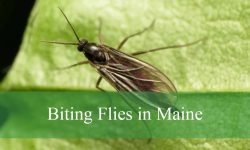Caterpillars are the larval stage of moths and butterflies. But moth caterpillars are the scariest due to their shapes, sizes, and colors. Besides that, these crawling insects have no close similarities to adult moths.
Common types of moth caterpillars are white-marked tussock, Isabella tiger, ruby tiger, Rose maple, and imperial moth caterpillars. Some species have spiky tufts of hair and furry appearance for defense or to scare away potential predators.
Knowing the features of moth caterpillars will help identify and classify them. We recommend using the pictures and description to identify different kinds of moth caterpillars in your garden or home.
We wrote this identification guide to share information about different moth caterpillar varieties. Take the time to read through and understand their behaviors and identification features.
Are Moth Caterpillars Poisonous?
Most moth caterpillars have hairs or spines that are connected to the poisonous glands in their bodies. When these hairs come into contact with human skin, it causes itching, pain, burning, blistering, and swelling.
Excessive consumption of some moth caterpillars causes stomach upsets among toddlers and pets (cats or dogs). We recommend seeking immediate medical attention since the venom can damage vital organs in the body.
Examples of poisonous moth caterpillars are lo moth, gypsy moth, flannel moth, and buck moth caterpillars. But these crawling insects do not attack humans and pets since they are non-aggressive. (Source: Cornel University).
The nasty stings occur when humans unintentionally come into contact with moth caterpillars. The accident happens when someone walks into the yard or garden infested with caterpillars.
Different Types of Moth Caterpillars
Moth caterpillars come in different shapes, sizes, and colors. These caterpillars have no resemblance to their adult counterparts after pupation. Here is a list of moth caterpillars with their descriptions and pictures:
White-Marked Tussock Moth Caterpillar
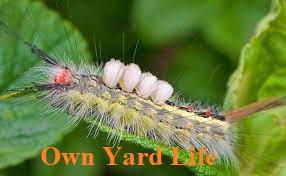
This is a furry black and yellow caterpillar that grows up to 1.3 inches long. The spiny moth caterpillar also has a redhead and tufts of yellowish-white hair around its body. I recommend not handling these grubs without protective gear.
These fuzzy moth caterpillars love feeding on the leaves of deciduous and coniferous trees. These colorful grubs also transform into a gray-fuzzy moth with white spots and black lines on the forewings after pupation.
The feathery antennae are identifiable features of this fuzzy moth. The white tussock moths are native to Florida and are nocturnal creatures in fall. Use chemical treatment to kill these nuisance moths in your home.
Scientific Name |
Orgyia leucostigma |
Host Plants |
Deciduous and coniferous trees |
Identification Features |
Black and yellow body with creamy yellow hairs and black pencil hairs. |
What They Turn Into |
Gray fuzzy moth with feathery antennae |
Isabella Tiger Moth Caterpillar

It is a black and orange caterpillar, also known as a banded woolly bear. The spiky moth can grow up to 2.3 inches long, and the body is covered in spines. But this caterpillar species is harmless since it does not bite or sting.
The caterpillar turns into an orange moth with black dots on the wings and black antennae. The broad bronze band around the midsection with furry head and tail help in the identification of this moth caterpillar.
Scientific Name |
Pyrrharctia isabella |
Host Plants |
Birches, clovers, asters, and maples |
Identification Features |
Bronze-brown band in the midsection with furry head and tail ends. |
What They Turn Into |
Orange moth with black antennae and black spots on the wings. |
Ruby Tiger Moth Caterpillar

It is a furry yellow caterpillar with an orange-yellow body and blackish-brown head. The tuft of foxy red hairs and spines are distinctive features for easy identification. You can also use the yellow stripes down the back in recognition of these grubs.
Ruby tiger moth caterpillar can grow up to 1.2 inches long with a voracious appetite. It loves feeding on the dock, goldenrod, ironweed, plantain, skunk cabbage, sunflowers, sweet gale, and other plants.
These caterpillars turn into beautiful red-winged insects after pupation. These furry insects have dark reddish-brown forewings and bright carmine hindwings with black spots.
Scientific Name |
Phragmatobia fuliginosa |
Host Plants |
Ironweed, goldenrod, dock, sunflowers, and skunk cabbage. |
Identification Features |
Brown body with golden brown spiny tufts around the slender body. |
What They Turn Into |
Pinkish-red moth with dark reddish-brown forewings and bright carmine hindwings |
Rosy Maple Moth Caterpillar

It is a type of green caterpillar with a bulbous pale brown head and rows of spiny black spots along its abdomen. The grub has a pair of black antennae and can grow up to 2 inches long.
The bright green caterpillar turns darker and develops green, pale, white, or black stripes around the body when approaching pupation. The fat green larva transforms into a beautiful pink furry moth after pupation.
The fuzzy pink antennae and legs with pink wings having yellow patches are distinctive features for identifying the rose maple moth. Refrain from handling the caterpillars since the spines can cause skin irritation.
Scientific Name |
Dryocampa rubicunda |
Host Plants |
|
Identification Features |
Rows of shiny and fleshy spines along the abdomen with red marking tail and brown head. |
What They Turn Into |
Pink furry moth |
Imperial Moth Caterpillar

Also called the giant imperial moth caterpillar, the dark brown grub has thin wispy filaments around the body with a row of yellow dots along its abdomen. The jagged-looking spines on the head and two rows of small spines along its back are identifiable features.
These large brown caterpillars can grow up to 5.5 inches long. They love feeding on the leaves of maples, oaks, pines, and sweetgums. Do not handle these caterpillars without wearing protective gear.
These giant imperial moth caterpillars turn into yellow moths with irregular reddish-brown blotches. But some imperial moth caterpillar species can be dark brown and orange.
Scientific Name |
Eacles imperialis |
Host Plants |
Pines, maples, oaks, sweetgums, and sassafras |
Identification Features |
Dark brown body with white or yellowish-green dots along its sides. |
What They Turn Into |
Dark brown and orange moth |
Cecropia Moth Caterpillar

It is the most unusual green moth caterpillar with bulging segments and rows of blue and yellow tubercles. Other distinctive features are orange ball-like spiny tubercles near the head and a menacing appearance.
The cecropia moth caterpillars are harmless and grow up to 4.0-4.5 inches long. These grubs feed on the birches, cherry, dogwood, elm, poplar, willow, and oak trees and turn into the largest moths in North America.
Scientific Name |
Hyalophora cecropia |
Host Plants |
Birch, cherry, and maple |
Identification Features |
Large pale-green body with colorful black-spined tubercles. |
What They Turn Into |
Brown moth with orange, beige, brown, and black patterns. |
Elephant Hawk Moth Caterpillar
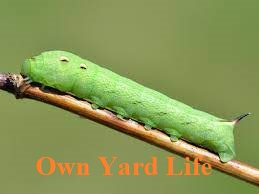
It is a dark-brown caterpillar with black spots and an elephant’s trunk appearance. The grub also has a brownish-gray body with a backward-shape horn on the back and eyespots near the head.
Mature elephant hawk moth caterpillars can grow up to 3 inches long and turn into the pupa stage. An adult moth has a fuzzy olive-brown body with deep to light pink bands around the wings and bright pink lines down its back.
Scientific Name |
Deilephila elpenor |
Host Plants |
Grapevine, willow shrubs, and primrose |
Identification Features |
Speckled-brown body with eyespots on its head and rows of black dots along the body. |
What They Turn Into |
Fuzzy olive-brown moths |
Tobacco Hawk Moth Caterpillar
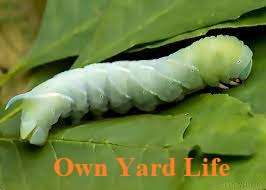
It is a green moth caterpillar also known as a tobacco hornworm. The diagonal white stripes along its body and small horn-like protrusion at the end are ideal for easy identification.
The green caterpillar can grow up to 3.1 inches long and resembles a tomato hornworm in your garden. The V-shaped markings on tomato hornworm help tell its difference from the tobacco hornworm.
The moth caterpillar turns into a brownish-gray moth with mottled beige, brown, and white patterns on the wings. The rows of yellowish-orange spots on the furry body are identification features for the moths.
Scientific Name |
Manduca sexta |
Host Plants |
Tomatoes, sacred datura, and coyote tobacco. |
Identification Features |
Diagonal white stripes and small horn-like protrusion. |
What They Turn Into |
Furry moth with two rows of yellowish-orange spots on its abdomen. |
Funerary Dagger Moth Caterpillar

It is a striking black caterpillar also called a paddle caterpillar. The large bright yellow markings and slender paddle-like protrusions from the jet-black body are unusual features for easy identification.
The black and yellow grub can grow up to 1.73 inches long before switching into the pupa stage. The black caterpillar loves feeding on the leaves of birches, elm, maple, cottonwood, and hickory trees.
The jet-black body caterpillars turn into gray and black moths after pupation. The wings have faint dark-gray watermark-like patterns for identification. Be sure to eliminate these moths from your house if you’re allergic to dust.
Scientific Name |
Acronicta funeralis |
Host Plants |
Maple, elm, hickory, birches, and cottonwood |
Identification Features |
Large bright yellow markings and slender paddle-like protrusion. |
What They Turn Into |
Gray and black moth with faint dark-gray watermark-like patterns |
Regal Moth (Royal Walnut Moth) Caterpillar

It is the largest and scariest moth caterpillar due to its black fleshy spines. The regal moth caterpillar is also called the hickory horned devil moth caterpillar, though harmless to humans and pets.
The turquoise-green caterpillar has an orangey-red head and black-tipped arched horns to create a scary appearance. These caterpillars can grow up to 6 inches long before undergoing pupation.
The grub turns into the most beautiful moth with dark-orange veins on its wings. The whitish-yellow patches on the wings and orange body are features for identifying regal moths.
Scientific Name |
Citheronia regalis |
Host Plants |
Hickories, sweet gum, and butternut |
Identification Features |
Pale green body with engorged segments and black fleshy spines. |
What They Turn Into |
Orange and gray-brown moth with dark orange veins. |
Southern Flannel Moth Caterpillar

It is a type of stinging caterpillar with a brown, soft, and fluffy appearance. The hairy caterpillar’s color ranges from golden brown to dark gray.
The puss moth caterpillar also has an orange stripe along the edges and can grow up to 25mm long. The white comb-like antennae is a distinctive feature for easy identification.
Also called the Italian asp, woolly slug, and puss mother caterpillar that feeds on the leaves of oak and elm trees. Refrain from handling the caterpillar without protective gear.
Scientific Name |
Megalopyge opercularis |
Host Plants |
Elm and oak |
Identification Features |
Body covered in a brown or orangey cloak with hidden sharp setae. |
Emperor Moth Caterpillar

It is a giant moth caterpillar with a green body covered in tufts of hair emerging from the black tubercles. Juvenile species have black and orange colors before turning green.
Mature green moth caterpillars grow up to 60mm long and love feeding on the leaves of woody plants. They are often seen in late May to August.
These caterpillars turn into brown and orange moths with distinctive hairy antennae. The large eyespots on the wings with dull red patterns make the moth spectacular.
Scientific Name |
Saturnia pavonia |
Host Plants |
Prunus, Rubus, and other woody plants |
Identification Features |
Dark green body with spiny yellow and black bumps around the segments |
Luna Moth Caterpillar

The grub has an oval brown head, six brown front legs, and rows of spiny bumps. The large four pairs of prolegs are the distinctive features.
The plump green moth caterpillar turns reddish before undergoing pupation. It can grow up to 6-65mm long.
The unusual caterpillar turns into a long-tailed moth with lime-green wings and strange-looking eyespots on each wing.
Scientific Name |
Actias luna |
Host Plants |
White birch, American sweet gum, and hickory. |
Identification Features |
Rows of orange or red dots along the back and sides |
Mullein Moth Caterpillar

It is a large worm-like caterpillar with a creamy-white body appearance. It has yellow and black patches around its body for easy recognition.
The caterpillar also has fine setae features along the back to ward off potential predators and defense. It can grow up to 50mm long.
Mullein moth caterpillars turn into a boldly-marked brown moth with tan and light brown streaks along their wings. These moths dwell in butterfly bush plants due to their vibrant colors.
Scientific Name |
Cucullia verbasci |
Host Plants |
Figwort |
Identification Features |
Pale grayish-green body covered in yellow and black spots. |
Brown-Tail Moth Caterpillar
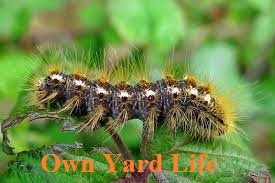
It is a reddish-brown caterpillar characterized by rows of white patches and long stinging pencil hairs. It can grow up to 38mm long and is often seen in the spring.
Brown-tail moth caterpillars feed on the leaves of hedgerow trees and other scrappy plants. Birch, oak, ash, and maples are the best spots to see these brown caterpillars.
The caterpillar turns into a white fuzzy moth after pupation. The brown tail of the moths with furry wings and fuzzy white heads are distinctive features for moth identification.
Scientific Name |
Euproctis chrysorrhoea |
Host Plants |
Blackthorns and hawthorns |
Identification Features |
Brown hairy caterpillar |
Diamondback Moth Caterpillar

The crawling insect has a slender body with dark spiny hairs that cause skin irritation and nasty rashes. The greenish-brown head, whitish dots, and yellow bands are other identification features.
The green moth caterpillar can grow up to 11mm long and loves feeding on the foliage of garden crops or shrubs. It turns into a grayish-brown flying insect after pupation.
Scientific Name |
Plutella xylostella |
Host Plants |
Trees and shrubs |
Identification Features |
Greenish body with tiny black hairs growing out of the white patches. |
Cinnabar Moth Caterpillar

The bright yellow and black striped caterpillar has a glossy sheen body. The grub is also covered in fine black and white spines for defense against potential predators.
The vibrant colors warn pets and humans to stay away since the sting can be poisonous upon handling. It can grow up to 30mm long.
The caterpillar turns into a spectacular red and black moth that loves fluttering around the garden during the day in summer.
Scientific Name |
Tyria jacobaeae |
Host Plants |
Ragwort |
Identification Features |
Black and yellow striped segments |
Io Moth Caterpillar

It is a venomous caterpillar that turns green with stinging needle-like tufts that resemble pine needles. These grubs can grow up to 2.3 inches long with a furry body and bluish-black eyespots on their wings.
The toxic substances in the tuft of hairs can cause skin irritation and pain. Refrain from touching these caterpillars without protective gear. The red and white stripes running along the sides are ideal features for easy identification.
Scientific Name |
Automeris io |
Host Plants |
Hackberry, willow, and blackberry |
Identification Features |
Tufts of stinging green spines cover the fat lime-green body with red and white stripes. |
Angle Shades Moth Caterpillar

The body color of this caterpillar varies from brown to yellow to bright green. These caterpillars can grow up to 4.5 cm long before undergoing pupation. The cocoons are deep reddish-brown with some shines.
Angle shades moth caterpillars love feeding on the dock, bramble, and stinging nettles. We encourage attracting birds, wasps, and ground beetles in your garden to help eliminate excess angle shades of moth caterpillars.
Angle shades moths have colorful wings that resemble withered autumn leaves. These moths are common in May and October in the United Kingdom. These moths are essential pollinators and play a vital role in the ecosystem.
Scientific Name |
Phlogophora meticulosa |
Host Plants |
Dock, bramble, and sallow |
Identification Features |
Green to mottle brown head with pale dorsal lines running on the back |
What They Turn Into |
A moth patterned with brown, green, and buff-pink colors. |
Cabbage Looper Caterpillar

The cabbage looper caterpillars are native to North America, Africa, Europe, Asia, and Australia. These grubs love feeding on cabbages, tulips, broccoli, kale, cauliflower, and collard greens.
These destructive creatures are not picky eaters and need to be eliminated before they destroy your crops. They have green bodies with a white line along their abdomens and are hairless for identification.
Cabbage looper caterpillars are also called Ni moths or cabbage moth caterpillars and turn into grayish-brown moths with eyespots on their wings. These dusty moths can cause allergies in toddlers.
Scientific Name |
Trichoplusia ni |
Host Plants |
Cabbage, kale, cauliflower, tulips, and broccoli. |
Identification Features |
Light green caterpillar |
What They Turn Into |
Dusty grayish-brown moth |
Final Thoughts from Experts
Moth caterpillars come in all shapes, colors, and sizes. Understanding the identification features of moth caterpillars will help differentiate between poisonous and non-poisonous species. (Sources: Florida Museum).
But different types of moth caterpillars are non-aggressive toward humans and other animals. We recommend not coming into contact with these caterpillars since the tufts of hair cause skin-level allergies.
We hope this information will help describe and identify moth caterpillars in your garden or backyard. Feel free to share the article with your friends or family members living in an area infested with caterpillars.
People Who Read This Also Read:




